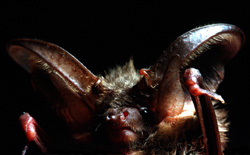Home
News
Travel Report Rwanda
Mountain Gorilla
Association
Scientific Board
Statutes
Andy Lee Lang Committee
Bank Account
Supporting Members
Mountain Gorillas in Rwanda
Ambassadors of the Mountain Gorillas
Education Center
Sponsorships
Bats
Contact
E-Card
German Version
powered by rw it-design |
Bats
More than a quarter of species of the native mammals are bats. Despite of
this important task in the local biodiversity, the public knowledge about
this animals is quite little. By and by the success of information activities
can be seen, but is still interfered by the old fears and myths about bats.
Those who get interested in the world of bats will hooked up by the fascinating
details and the wide field of science that makes the bat one of the most interesting
animals.
 Approximately 60 million years old fossils have been found that show ancient
bats closely resemble our recent species. That means after basic design has
been finished, nature had a long period and a big workbench to enhance the
skills of that group of animal. About 930 species covers the order of bats.
The biggest representative is a fruit bat with a wingspan of 1.7 meters, the
smallest weights 1.5 grams and is the lightest mammal of the world. Flight
performance, echolocation and hibernation are just examples of the specialities
of bats. Approximately 60 million years old fossils have been found that show ancient
bats closely resemble our recent species. That means after basic design has
been finished, nature had a long period and a big workbench to enhance the
skills of that group of animal. About 930 species covers the order of bats.
The biggest representative is a fruit bat with a wingspan of 1.7 meters, the
smallest weights 1.5 grams and is the lightest mammal of the world. Flight
performance, echolocation and hibernation are just examples of the specialities
of bats.
Other then on other continents where bats use the whole spectrum of plants
and prey, European bats feed only insects. This makes bats to harmless and
useful animals. The most famous species of bats is the vampire. Its affinity
to blood made brought this little animal into horrible fairytales and myths.
But this bat is only native in South- and Middle America.
Endangered
Bats are not dangerous for human furthermore they are very useful. But there
is no joint venture, because human behaviour and interests are dangerous
for bats. All tasks in the life of bats are badly influenced by human made
factors.
Habitats for hunting insects and finding roosts are changed to agricultural
production units. Reduced or poisoned insect populations make feeding difficult
and poisonous. Clean, closed attics leave no place for breeding bats. At
last hibernating bats get disturbed by several economic and non-economic
reasons.
All species of bats in Austria are protected by law. Federal countries have
different priorities but in general bats are protected. This is also supported
by international laws. Several species are protected in all European countries.
Special protection measures have to be installed for that species.
Help
Rules and Laws are the presupposition and give the frame for successful protection
but to live the idea of animal protection is in the responsibility of everibody.
The mission of the Fledermauskundliche Arbeitsgemeinschaft is the exploration
and conservation of native bats. The three main tasks of the Fledermauskundliche
Arbeitsgemeinschaft are research, information and a care station for bats.
The Fledermauskundliche Arbeitsgemeinschaft is a registered non-profit organisation.
In the past several research activities had been done eg. survey of the
bat population of four federal countries, preparation for the protection
of nature
conservation areas and other studies about bats. The experience got in the
field is the base for public education and information events for all ages.
The most extensive work is the care station. About 1000 bats a year are
brought to the care station. Fortunately most of them can released after
a short
residence in the station. But some are injured and need special help and
medical care.
In such Situations the Tierklinik Strebersdorf helps with medical support.
The Specialists of the Tierklinik Stebersdorf are experianced in handling
bats and make successful surgery on all size of bats. Numerous broken bones
were splinted by special developed methods. Special narcosis make the most
careful treatment of the animals possible.
|

